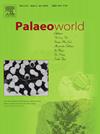Annual growth bands in the late Carboniferous reef-building colonial rugose coral Ivanovia and their environmental significance
IF 1.7
3区 地球科学
Q2 PALEONTOLOGY
引用次数: 0
Abstract
Annual growth bands featuring with high- and low-density bands of massive reef-building corals are considered to be physiological response to seasonal changes in environment and have been widely used as environmental and climatic proxies. Here, we conduct paleontological and geochemical analysis on the late Carboniferous massive coral (Ivanovia) with distinct density bands from Houchang area, South China. Four Ivanovia species including Ivanovia cf. manchurica, I. podolskiensis, I. guizhouensis, Ivanovia sp. have been found in the study area. Aluminum (Al) content and oxygen isotope (δ18O) of the annual growth bands in Ivanovia sp. suggest that high-density bands are probably formed during hot and rainy seasons with high temperature and more terrestrial input. In contrast, low-density bands are generally constructed during cooler periods with optimal environmental conditions, consistent with the modern tropical reef-building coral density bands. Spectral analysis of the Al and δ18O series from the Ivanovia sp. reveals significant 2–7 yr cycles close to the cyclicality (2–7 yr) of modern El Niño–Southern Oscillation (ENSO). This study highlights the coral annual growth bands and ENSO-like variability during the late Carboniferous.
晚石炭世造礁殖民地斑珊瑚Ivanovia的年生长带及其环境意义
大型造礁珊瑚的年生长带以高密度带和低密度带为特征,被认为是对环境季节变化的生理反应,已被广泛用作环境和气候指标。本文对华南后昌地区晚石炭世具有明显密度带的块状珊瑚(Ivanovia)进行了古生物学和地球化学分析。在研究区发现了4种伊万诺娃种,包括满洲里的伊万诺娃、podolskiensis、贵州的伊万诺娃和伊万诺娃。Ivanovia群落年生长带的铝(Al)含量和氧同位素(δ18O)表明高密度带可能是在高温、陆源输入较多的热雨季形成的。相比之下,低密度带通常是在较冷的时期和最佳的环境条件下建造的,与现代热带造礁珊瑚密度带一致。光谱分析表明,El - Niño-Southern涛动(ENSO)的2-7年周期接近现代El - Niño-Southern涛动(ENSO)的2-7年周期。本研究强调了晚石炭世珊瑚的年生长带和enso样变率。
本文章由计算机程序翻译,如有差异,请以英文原文为准。
求助全文
约1分钟内获得全文
求助全文
来源期刊

Palaeoworld
PALEONTOLOGY-
CiteScore
4.00
自引率
5.90%
发文量
95
期刊介绍:
Palaeoworld is a peer-reviewed quarterly journal dedicated to the study of past life and its environment. We encourage submission of original manuscripts on all aspects of palaeontology and stratigraphy, comparisons of regional and global data in time and space, and results generated by interdisciplinary investigations in related fields. Some issues will be devoted entirely to a special theme whereas others will be composed of contributed articles. Palaeoworld is dedicated to serving a broad spectrum of geoscientists and palaeobiologists as well as serving as a resource for students in fields as diverse as palaeobiology, evolutionary biology, taxonomy and phylogeny, geobiology, historical geology, and palaeoenvironment.
Palaeoworld publishes original articles in the following areas:
•Phylogeny and taxonomic studies of all fossil groups
•Biostratigraphy, chemostratigraphy, chronostratigraphy
•Palaeoecology, palaeoenvironment and global changes throughout Earth history
•Tempo and mode of biological evolution
•Biological events in Earth history (e.g., extinctions, radiations)
•Ecosystem evolution
•Geobiology and molecular palaeobiology
•Palaeontological and stratigraphic methods
•Interdisciplinary studies focusing on fossils and strata
 求助内容:
求助内容: 应助结果提醒方式:
应助结果提醒方式:


